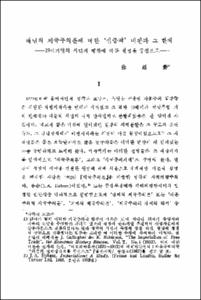言語階層에 따른 意味解釋 考察
- Alternative Title
- Semantic Interpretation on Linguistic Levels
- Abstract
- Chomsky 문법은 意味가 완전 除外되었던 Syntactic Structures를 시발점으로 하여 4단계의 변천을 겪어왔다. 그러나, Aspects에서는 의미가 문법의 한 獨立部門으로 도입되었고, 심층구조가 投射規則을 통한 의미해석의 모든 情?를 內包하고 있었다. 이 標準理論은 表層構造에서도 의미를 해석해 낼 수 있는 여러 反證으로 말미암아 곧 黃大標準理論에 의해 수정 대치되었으나, 이 理論도 表層構造 意味解釋을 위한 적절한 규칙을 提示하지 못하는 문제점을 보였다. 이러한 궁지에서 Chomsky문법을 구원하고 새로운 의미해석을 시도한 것이 痕迹理論이다. REST에 의하면 심층구조의 文法關係는 추후 의미해석을 위해 NP가 이동하고 난 후의 흔적 t를 표시함으로써 표층구조?? 表示가능하다고 생각하면서, 意味는 흔적표층구조에서 分析規則, 解析規則, 結束條件 등을 통하여 해석되어지며 최종적으로 理論形式에 이른다고 주장한다.
本 論文은 上記한 사실을 기초로 하여 언어 계층에 다른 의미해석을 특히 Chomsky문법 발전과 관련하여 考察하였다.
本 論文의 硏究 結果를 요약하면 다음과 같다.
첫째, 拙稿에서는 投射規則의 出力인 순수하게 문법직인 언어 능력을 반영하는 言語的 意味에 局限하고 있으나, 한 문장의 전체적인 의미해석은 言語遂行 즉 발화와 관련된 意味도 포함시켜야 하며,
둘째, EST는 最終句構造標識에 작용하여 의미를 해석해 내는 어떤 意味部門과 해석규칙 等으로 그 문법이 보장되어져야 하며,
셋째, 흔적표층구조를 音韻 및 意味表示의 入力으로 하는 核心文法은 실제 사용하는 統語構造를 중시하게 됨으로써 문법이 한결 具體化되었으며,
넷째, 흔적이론의 도입으로 각종 變形이 外在的 順序없이 任意的으로 적용되어지며, 그 결과 結語上의 適格文이 過剩生成 되어지거나 순수 표층해석이 이런 류의 문정 出現을 방지함을 볼 수 있었다.
Chomskyan grammar has undergone four stages of development, including its initiation in Syntactic Structures, where meaning was totally excluded from grammar. In Aspects, however, meaning appeared as one of the tripartite components of grammar, and its interpretation through a system of rules (i.e., Projection Rules) was entirely dependent upon deep structures. This hypothesis(ST), confronted with the counterexamples that meaning can also be interpreted from surface structures, in turn gave place to EST. Arriving at this stage Chomskyan grammar seemed to be trapped in a cul-de-sac, with no adequate rule to explain new semantic interpretation from surface structures. Trace Theory saved Chomskyan grammar from this predicament, and provided a new approach to semantic interpretation. Assuming that grammatical relations of deep structure may be preserved in surface structures, for later semantic interpretation, through marking the anaphoric trace left by the moved NP, this theory (REST) contends that meaning is interpreted from trace-preserving surface structures through construal rules, interpretive rule, and conditions on binding, finally, leading to logical form.
This paper, on the basis of the information above mentioned, aims at studying semantic interpretation on linguistic levels and especially in connection with the development of Chomskyan Grammar.
The results shown in this study could be summarized as follows.
First; Although this puts focus on linguistic meaning, the output of projection rules, that does reflect pure grammatical competence, the total meaning of a sentence must include meaning in connection with utterences, let alone meaning in connection with the linguistic sentence type.
Second; EST must be supplemented with a new semantic component and actual interpretation rules in grammar to operate mainly on final derived phrase markers.
Third; Given surface structures with traces as input of phonological and semantic representation, grammar (Core grammar) places such a great emphasis on syntactic structures that it seems to be far more concrete.
Fourth; As Trace theory can dispense with rule ordering and obligatoriness of rule application, syntactic rules tend to overgenerate syntactically well-formed sentences, which may, fortunately, be filtered out by a theory of surface interpretation.
Chomskyan grammar has undergone four stages of development, including its initiation in Syntactic Structures, where meaning was totally excluded from grammar. In Aspects, however, meaning appeared as one of the tripartite components of grammar, and its interpretation through a system of rules (i.e., Projection Rules) was entirely dependent upon deep structures. This hypothesis(ST), confronted with the counterexamples that meaning can also be interpreted from surface structures, in turn gave place to EST. Arriving at this stage Chomskyan grammar seemed to be trapped in a cul-de-sac, with no adequate rule to explain new semantic interpretation from surface structures. Trace Theory saved Chomskyan grammar from this predicament, and provided a new approach to semantic interpretation. Assuming that grammatical relations of deep structure may be preserved in surface structures, for later semantic interpretation, through marking the anaphoric trace left by the moved NP, this theory (REST) contends that meaning is interpreted from trace-preserving surface structures through construal rules, interpretive rule, and conditions on binding, finally, leading to logical form.
This paper, on the basis of the information above mentioned, aims at studying semantic interpretation on linguistic levels and especially in connection with the development of Chomskyan Grammar.
The results shown in this study could be summarized as follows.
First; Although this puts focus on linguistic meaning, the output of projection rules, that does reflect pure grammatical competence, the total meaning of a sentence must include meaning in connection with utterences, let alone meaning in connection with the linguistic sentence type.
Second; EST must be supplemented with a new semantic component and actual interpretation rules in grammar to operate mainly on final derived phrase markers.
Third; Given surface structures with traces as input of phonological and semantic representation, grammar (Core grammar) places such a great emphasis on syntactic structures that it seems to be far more concrete.
Fourth; As Trace theory can dispense with rule ordering and obligatoriness of rule application, syntactic rules tend to overgenerate syntactically well-formed sentences, which may, fortunately, be filtered out by a theory of surface interpretation.
- Issued Date
- 1983
- Type
- Research Laboratory
- Alternative Author(s)
- Koo, Ja-Eun
- Publisher
- 연구논문집
- Language
- kor
- Rights
- 울산대학교 저작물은 저작권에 의해 보호받습니다.
- Citation Volume
- 14
- Citation Number
- 1
- Citation Start Page
- 213
- Citation End Page
- 228
- Appears in Collections:
- Research Laboratory > University of Ulsan Report
- 파일 목록
-
-
Download
 000002024102.pdf
기타 데이터 / 1.05 MB / Adobe PDF
000002024102.pdf
기타 데이터 / 1.05 MB / Adobe PDF
-
Items in Repository are protected by copyright, with all rights reserved, unless otherwise indicated.